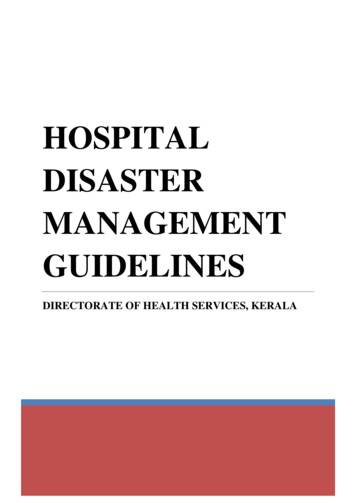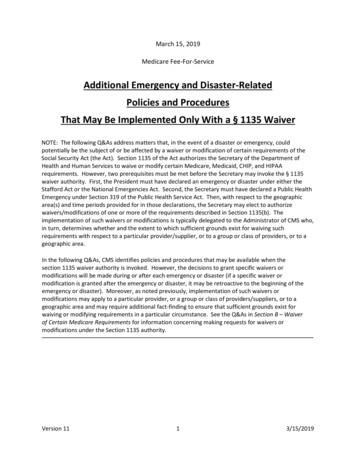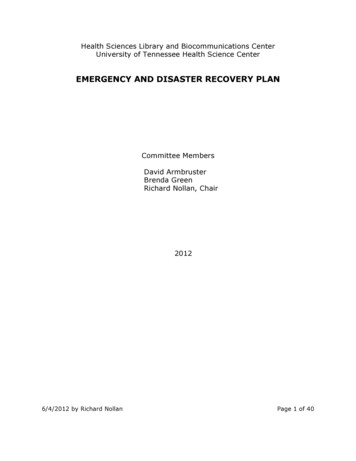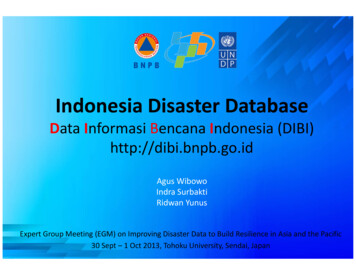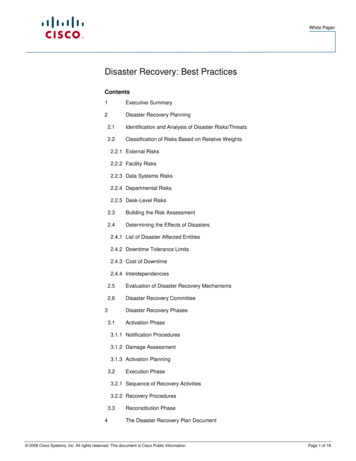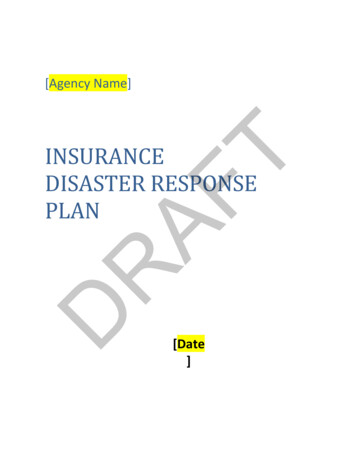
Transcription
[Agency Name]DRAFTINSURANCEDISASTER RESPONSEPLAN[Date]
RDAFT
IntroductionIn the event of a disaster requiring an extraordinary response, the [state insurance regulatoryentity] has adopted the following disaster response plan.What this document providesAFTThis document provides a template for a department of insurance to use when assistingconsumers following a disaster. The document will also provide guidance to insurers and otherlicensees in advance of a disaster.This document details how a department of insurance can work with other agencies to assistconsumers, including: Federal agencies; State or local agencies; National Association of Insurance Commissioners (NAIC); and Other state Departments of Insurance (DOIs). This document does not provide information regarding a Continuity of Operations Plan (COOP).Check to see if your department has a COOP that provides detailed information regarding how itis to be implemented.The purpose of the disaster response plan Provide states with information regarding quick and effective responses to meet the insuranceinformation needs of its citizens; and Provide information regarding coordination of resources with other state agencies to mitigatethe effects of a disaster. D RThe purpose of the disaster response plan is to:The disaster response plan will be activated by the Commissioner,Director, or Superintendent. It will be implemented by the disaster orincident management team. 2020 National Association of Insurance Commissioners
Information the disaster response plan providesThis disaster response plan template provides information to assist state insurance departmentsin responding to disasters. This disaster response plan is scalable to respond to disastersimpacting: Limited areas within the state; Several locations throughout the state; or Impacting the entire state. NAIC Disaster Assistance ProgramAFTThe NAIC Disaster Assistance Program is a series of services provided by the NAIC to anymember jurisdiction experiencing the aftermath of a disaster where additional support is needed.The NAIC can provide the following services following a disaster: Disaster Relief Call Center Disaster Recovery Center Insurance Regulator Staff Communications Services NAIC Coordinated Data Call Services are provided once a formal request is made by a NAIC member (a jurisdiction’sappointed/elected Insurance Commissioner) to the NAIC Officers, asking them to direct NAICsenior management to allocate budgeted funds and resources toward their need for disaster reliefassistance. The day-to-day project is then overseen by the NAIC Director of Member Serviceswho coordinates a variety of NAIC department staff overseeing operations and volunteersthroughout the length of services needed.RWays a jurisdiction can prepare to receive NAIC assistanceJurisdictions can prepare information which will better facilitate NAIC assistance after acatastrophic event. These items may be incorporated as part of your jurisdictions BusinessContinuation Plan. Jurisdictions need to consider how they want calls and complaints tracked byNAIC volunteers and provide templates if appropriate.DThe following are some high-level action items to do prior to contacting the NAIC: Identify your critical staff and who will be coordinating with the NAIC; Assess level of impact to your staff. This level of impact may determine the support you mayneed from the NAIC; Assess the functionality of your systems and facilities (i.e. phone, internet, othercommunications, and office) after the event; Assess access to power and your critical infrastructure; Assess business impact analysis – what is the minimum you need to function?; If possible, consider the type of assistance you may need: call center overflow, onsiteregulatory staff support, website, or remote office. However, the NAIC is also prepared toconsider new services to meet your unique needs; Document how a trusted third party may access your communications systems: phone andinternet; Prepare and provide talking points for the NAIC, FAQs, jurisdiction guidelines (i.e. emergencyadjuster licensing rules) which can be shared with call center staff and onsite DRC volunteers; 2020 National Association of Insurance CommissionersPage 1
and Share jurisdiction-issued Bulletins and how we are to handle them. NAIC services set‐up time after approval of assistanceThe NAIC is ready to help at any time after a member has requested assistance. Call center: within 24-48 hours after contact; DRC volunteers may be available within 48-72 hours after contact; Communications services are available within 24-48 hours after contact and member approvalof information; and NAIC Coordinated Data Call within 24-48 hours after contact. AFTAdditional informationWhere possible, the NAIC may reach out to a member jurisdiction prior to an imminent disasterto offer information about our program or answer any questions they may have about systemswhich may be affected in the event of a disaster.NAIC Research and Government Relations departments are able to participate in briefings withFBIIC, FEMA and Homeland Security to share information from, and to, NAIC jurisdictions.NIPR and/or IIPRC are able to assist affected jurisdictions who may need emergency adjusterlicenses, and/or help processing product filings.Disaster relief call centerNAIC works with your department’s technical team to connect a 1-800 NAIC telephone line and/orcomputer system (SBS) with your jurisdiction’s consumer phone line and/or complaint trackingsystem. D Call center is staffed with experienced insurance department regulator volunteers capable ofanswering consumer concerns. Flexible enough to handle your entire call volume, allowing your staff to assist people in thefield. Call center may also be set to roll-over to regulator volunteers whenever you experience calloverflow. R Cost: There is no cost to your jurisdiction for this service; NAIC covers the cost for the 1-800 phone line; call center equipment, facilities andcoordination; and the travel/lodging reservations and expense for regulator volunteers; and Your fellow Members/Commissioners provide their state regulator staff as volunteers. Disaster recovery center (DRC) insurance regulator staffNAIC facilitates and coordinates insurance department regulator volunteers to staff yourdesignated DRC location(s). Volunteers cover 1-2 week shift rotations to man the daily operation of the DRC; NAIC will arrange travel and lodging for the assigned regulator volunteers; and If needed, NAIC can help provide loaner laptops or cell phones for regulator volunteer use ata DRC location. 2020 National Association of Insurance CommissionersPage 2
Cost: There is no cost to your jurisdiction for this service; NAIC covers the cost of the loaner equipment and travel/lodging expenses for the regulatorvolunteers; and Your fellow Members/Commissioners proffer their state regulator staff as volunteers. To deploy this service, an insurance department staff/disaster coordinator contacts TrishSchoettger, NAIC Director Member Services tschoettger@naic.org or call 816.783.8506. She willcoordinate a call with the Member/Commissioner, NAIC President and NAIC CEO or COO toutilize these services.NAIC‐hosted insurance department websiteCost: AFTIn the case where the affected jurisdiction has lost use of its facility or their website becomesinoperable, the NAIC can act as interim host for the jurisdiction’s insurance department website.If needed, the NAIC can also serve as a resource to communicate your updated status or changeinformation to other jurisdictions and/or agencies.There is no cost to your jurisdiction for this service; and NAIC covers the cost of hosting the site. NAIC‐coordinated data callDRThe NAIC assists states with data calls related to the collection of claims data following disasters.Data calls are typically conducted weekly immediately after a disaster and then biweekly ormonthly as a higher percentage of claims close. 2020 National Association of Insurance CommissionersPage 3
PreparationThe steps to preparationA DOI needs to promptly and efficiently respond to a disaster. Effective response to a disasterrequires preparation and planning, including: Identifying appropriate staff to perform necessary activities;Training of appropriate staff;Identifying available resources; andIdentifying any resource shortfalls and how these might be addressed.Important planning considerations AFTPreparedness for disasters requires identifying resources and expertise in advance and planninghow these can be used in a disaster. Planning considerations include:Putting procedures in place for internal tracking and reimbursement costs expended by theDOI in response to a disaster; Designating a team of individuals and assigning responsibilities to ensure everyone on theteam understands their roles and responsibilities during a disaster situation; and Updating plans and procedures based upon post-mortem evaluation of the DOI’s performancein prior disaster response efforts. Available trainingAs a part of efforts to prepare for response to disasters, state departments of insurance andagencies participate with local jurisdictions and private entities in exercises and training.RStaff should be periodically trained on how to assist consumers during a disaster.Training regarding information on FEMA assistance programs as well as the National FloodInsurance Program is recommended.FEMA has free courses available to emergency management teams. These courses can be foundby using the following link: https://training.fema.gov/is/.DThe NFIP has developed a reference guide on flood-related issues for state insurance regulatorsand other officials. This document can be found using the following eferencev18 508 V4.1.pdf 2020 National Association of Insurance CommissionersPage 4
Insurance contact information that a DOI should regularly collectIt is important for a DOI to maintain current insurance company contacts for insurers licensed todo business in the state, including non-admitted surplus lines insurers. Some states may maintaincontact information in State Based S, another database, or through a Microsoft Outlook contactlist obtained an annual request.Partnerships with private volunteer organizations can also be useful in coordinating responseafter a disaster. [State Insurance Department] should identify consumer or non-profit organizationsthat would be open to a partnership.Insurance company contacts: AFTFollowing a disaster, a DOI will likely need to contact insurers. The contact information shouldinclude:Insurers doing business in a state; A primary contact and a secondary contact (both would likely be a member of the insurer’sdisaster response team); and High-level senior management to respond to questions or issues promptly. Requirements of insurance company contactsAfter a disaster, state insurance regulators will need to be able to contact insurers for information.Contacts should: Be able to provide coverage data and loss statistics, by county or region, according to astandardized format developed by the DOI; Be knowledgeable regarding their internal information systems and sources and authorized toaccess such systems so applicable and timely information can be provided upon the requestof the DOI; and Be able to respond to requests for information from legislators, governor’s office, FEMAofficial, or press inquiries; and R Other necessary contactsDDOIs will need contacts for local, state, and federal officials (these should be maintained andupdated). Contacts will report other disaster information to the department ofinsurance, including lists of company claim offices and phone numbers,adjuster information, and company toll-free numbers, etc.Types of information that should be ready for dissemination in theevent of a disasterFollowing a disaster, a DOI will be responsible for helping consumers regarding claims. Some of 2020 National Association of Insurance CommissionersPage 5
the items a DOI will want to have on hand to provide to consumers include: Consumer brochures; Consumer alerts; Insurer Contacts for Consumers; and Other forms of information relating to preparation and response to all types of disasters (thisinformation should be updated prior to a disaster). The NAICs Transparency and Readability of Consumer Information (C) Working Group created adocument to help guide consumers through a claim following a disaster. This document can be passedout following a disaster: NAL%207%2023%202019.pdfAFTTypes of data a DOI should collect regarding disastersA DOI should define the appropriate area in their department responsible for creating andmaintaining a database that holds coverage data and loss statistics collected from insurers. If aDOI does not have the resources to maintain a database, the NAIC can provide this service.Information to be collected (generally collected by ZIP code) includes such items as the: Number of claims reported; Number of claims closed with and without payment; Paid losses; and Incurred losses. Data collection tools the NAIC can provideRThe NAIC can provide the data template adopted by the NAIC Property and Casualty (C)Committee and Executive Committee, and Plenary if the department of insurance does not haveits’ own data call template. This template can be found on the Catastrophe Insurance (C) WorkingGroup’s webpage under the Related Documents tab. The link to the webpage is:https://www.naic.org/cmte c catastrophe.htm.The NAIC coordinated data callDThe NAIC assists states with data calls related to the collection of claims data following disasters.Data calls are typically conducted weekly immediately after a disaster and then biweekly ormonthly as a higher percentage of claims close. The length of time data is collected is usuallydependent upon the severity of the event. For example, a minor hurricane, like Irma, won’tnecessitate weekly reporting, even in the beginning. Having the NAIC assist with a data call couldrequire a confidentiality agreement if the state does not already have one that would encompassthe data call.Types of information a DOI, in coordination with Public Affairs shouldmaintain, update and post on the state’s website and distributed viasocial media https://www.insureuonline.org/disaster prep flood.pdf https://www.insureuonline.org/disaster prep tornado.pdf https://www.insureuonline.org/disaster prep hurricanes.pdf https://www.insureuonline.org/disaster prep wildfires.pdf 2020 National Association of Insurance CommissionersPage 6
https://www.insureuonline.org/disaster prep earthquakes.pdf https://www.insureuonline.org/home inventory checklist.pdf https://www.naic.org/documents/consumer alert wake of the storm.htm https://www.naic.org/documents/consumer alert flood insurance understanding risk.htm Resources required for emergency responseThe availability and capability of resources needs to be determined and include the following:AFT People; Facilities; Materials and supplies; and Funding; and Information regarding threats or hazard. Periodically review resources dedicated to the Disaster Response Team tomake certain there are enough cell phones, laptops, and other equipment andmaterials available for staff.RDisaster Recovery Team Personnel within the department of insurance shouldbe identified to act as first responders if the department of insurance isrequired to respond to an emergency.DOI employees are divided into those who will work outside of the office andthose who will work at the DOI in an onsite or offsite call center.Contact information for members of the team should be maintained.DEmployees should receive periodic training and updates on procedures forassisting consumers in the event of a disaster.The department of insurance shall maintain Disaster Recovery supplies andinformation for use by the TeamBrief description of the Major Incident Management Functions (Seeorg chart template ‐ Appendix 1)COMMANDSets the incident objectives, strategies, and priorities and has overall responsibility for theincidentOPERATIONSConducts operations to reach the incident objectives. Establishes tactics and directs alloperational resources. 2020 National Association of Insurance CommissionersPage 7
PLANNINGSupports the incident action planning process by tracking resources, collecting/analyzinginformation, and maintaining documentation.LOGISTICSArranges for resources and needed services to support achievement of the incident objectives.FINANCE AND ADMINISTRATIONAFTMonitors costs related to the incident. Provides accounting, procurement, time recording, andcost analysis.DRKeep in mind, larger states may have more resources available than smallerstates. See important note to DOIs. 2020 National Association of Insurance CommissionersPage 8
Disaster Response/Incident Management TeamResponse Leadership Team (Your State Emergency Management Agency would call this theCommand Support Staff)The purpose of this team is to: Provide direction before, during, and after a disaster; Ensure periodic review and assessment of the State Disaster Response Plan and hold incidentmanagement team accountable for implementation; and Test and update the plan on a regular and consistent basis. LocationAFT This team is located at the [Home office] unless an alternative location is needed.Duties:Upon notification of a significant disaster, the Commissioner, Superintendent, or Director will notifythis team to begin implementation of the Disaster FResponse Plan.Identify which other disaster response units should be activated.Members:The response leadership team should include the following:DR Incident Commander (commissioner, director, superintendent, chief deputy, or their designee); Public Information Officer (the person that handles media and communication requests); Safety Officer (this person is the HR chief manager); Finance /Administration Section Chief; Legal Counsel; Emergency Operation Center (EOC) Liaison Officer (this could be your lead consumer affairsstaff member); and Any other positions as required, who report directly to the Incident Commander (they mayhave an assistant or assistants as needed). Incident Commander (IC) –(may be the Agency Head or their designee)The IC is responsible for all incident action plans and activities to sustain critical functions andservices. These tasks include: Developing strategies and tactics before the execution of action plans in the event of adisaster; The ordering and release of resources; and The overall authority and responsibility for conducting incident operations. The IC is responsible for: The management of all incident operations; Ensuring overall incident safety; 2020 National Association of Insurance CommissionersPage 9
Assessing the situation and notifying internal teams and departments; Appointing others; All ICS management functions until they delegate a function; Providing information services to internal and external stakeholders; and The management of all operations at the disaster site. It is possible for the IC to accomplish all management functionsduring the aftermath of a small event.AFTThe IC only creates the sections that are needed. If a section is not staffed, theIC will personally manage those functions.Public Information Officer (PIO)The Public Information Officer is responsible for interfacing with the public, industry and mediaand/or with other agencies with incident-related information requirements.The PIO is responsible for: Drafting and issuing all public announcements; Making all press releases; Establishing an event-specific webpage (if needed); Sending event-specific updates out via social media and posting them online; and Giving all interviews with the communications media relative to the incident and the Agency’saction plan to address the situation. The PIO establishes communications with PIOs in other StateRAgencies and the Governor’s Media Office to convey situation status, progress toward resolving theincident and any actions needed in support of or to address the situation.DThe PIO works directly with the Incident Commander (IC) and Agency Head on allsensitive communications and may seek advice and counsel from other members of theCommand Support Staff on legal or personnel matters and from the Section Chiefs onbackground relating to the situation and the actions the Agency are taking. 2020 National Association of Insurance CommissionersPage 10
Safety Officer (SO)The Safety Officer monitors incident operations and advises the Incident Commander on allmatters relating to operational safety, including the health and safety of agency personnel.The SO is responsible for: Monitoring conditions and developing measures for assuring safety of personnel; Advising the IC about incident safety issues; Conducting risk analyses; Implementing safety measures; Monitoring building accessibility; and Communicating with IC and staff. AFTLegal Counsel (LC)The Legal Council is the member of the Incident Command Support Team who provides legalcounsel to the Incident Commander.Examples of support would include: Providing advice relative to Agency jurisdiction and contractual obligations; and Other tasks as assigned by the IC. The LC may also be asked to: Review any public statements to be issued by the Public Information Officer (PIO); Provide opinion and guidance on employee relations-based issues; and Provide opinion and guidance on issues that relate to the Agency mission and the public. REOC Liaison Officer (ELO)The Liaison Officer is the point of contact for representatives of other governmental agencies,nongovernmental organizations, and the private sector.DThe ELO provides a liaison between the DOI and the State’s Department of EmergencyManagement and Homeland Security (DEMHS) Department, especially when DEMHS haselected to activate its Emergency Operations Center (EOC).A close working relationship between the Agency and the EOC is required for timelycommunication and action appropriate to directives received. The EOC Liaison Officer willrepresent the Agency at the EOC and establish ongoing communications and scheduled statusreviews with the Agency Incident Command. 2020 National Association of Insurance CommissionersPage 11
Roles and ResponsibilitiesFinancial & Administration Section ChiefThe Financial and Administration Section Chief is a member of the Incident Command GeneralStaff. This person is also the leader of the Administration Section. In the context of the Continuityof Operations program, the Financial and Administration Section Chief is responsible for theinternal processes within the Agency, including financial and human resource functions, whichare necessary to enable the critical functions being addressed by the Operations Section.AFTThe Administration Section Chief sustains or recovers processes to maintain the fiscal integrityof the Agency and ensure that essential human resource processes are sustained. TheAdministration Section Chief works closely with the Operations and Logistics Sections to identifyrequirements and assess available options.The Finance/Administration Section Chief is responsible for:D All financial, administrative, and cost analysis aspects of an incident; Maintaining daily contact with agency administrative headquarters on finance andadministration matters; Meeting with assisting and cooperating agency representatives; Advising the IC on financial and administrative matters; Developing the operating plan for the Finance/Administrative Section; Coordinating finances at the local level; Establishing or transitioning into an existing Finance/Administrative Section; and Supervising and configuring section with units to support as necessary; Contract negotiation and monitoring; Timekeeping; Cost analysis; Compensation for injury or damage to property; and Documentation for reimbursement (e.g., under mutual aid agreements and assistanceagreements). R The Finance/Administration Section is set up for any incident that requiresincident- specific financial management.The Time, Compensation/Claims, Cost, and Procurement Units may beestablished within this Section.Finance and Administration Section Team LeadsThe Finance and Administration Section Team Leads should be a qualified member of the 2020 National Association of Insurance CommissionersPage 12
Incident Command General Staff. This person reports to the Administration Section Chief.Finance and Administration Section Team Leads are responsible for: The coordination of the initial action plan execution and recovery efforts for one of theAdministration Section Team; Business continuity interruption preparedness; Response coordination; and Post-interruption corrective action based on lessons learned for the functions that are part ofthe normal operational responsibilities of the work group. AFTIn the National Incident Management System (NIMS) these Team Leads oftenhead Branches or Divisions.Section Chiefs will determine the organization appropriate under respectiveSectionsLogistics Section ChiefThis Logistics Section Chief is a member of the Incident Command General Staff and is the leaderof the Logistics Section.The Logistics Section Chief is responsible for: D The resources and processes needed to sustain or recreate the work environment forOperations and Administration Section functions (in the context of the Continuity of OperationsProgram), including facility, technology, equipment and supplies; Addressing plant, tool, technology and information security (including HIPAA) requirements forthe Incident Command; and Working closely with the Operations and Administration Sections to identify requirements andassess available options. R The Logistics Section is responsible for all services and support needs,including: Ordering, obtaining, maintaining, and accounting for essential personnel, equipment andsupplies; Providing communication planning and resources; Setting up food services for responders; Setting up and maintaining incident facilities; Providing support transportation; and Providing medical services to incident personnel. Operations Section ChiefTypically, the Operations Section Chief is the person with the greatest tactical expertise in dealingwith the problem at hand. The Operations Section Chief is a member of the Incident Command 2020 National Association of Insurance CommissionersPage 13
General Staff and the leader of the Operations Section. This person is responsible for thesustenance or recovery of the functions within the agency that serve the citizens of the state. TheOperations Section Chief may have one or more Deputies who are qualified to fill this position.The Operations Section Chief is responsible for: Directly managing all incident tactical activities; Implementing the Incident Action Plan (IAP); Developing and implementing strategy and tactics to carry out the incident objectives; Organizing, assigning, and supervising the tactical response resources; and May have one or more Deputies, who are qualified to assume these responsibilities. (This isrecommended where multiple shifts are needed, as well as for succession planning). AFTOperation Section Team LeadsAn Operation Section Team Lead is a qualified member of the Incident Command General Staffand reports to the Operation Section Chief. This individual is responsible for the coordination ofthe initial action plan and recovery effort of the Operations Section Teams.Operation Section Team Leads are responsible for: Pre-incident preparedness; Incident action plan coordination; and post-incident corrective action based on lessons learned for the functions that are part of thenormal operational responsibilities of the work group. Planning Section ChiefDRThe Planning Section Chief is a member of the Incident Command General Staff and leader ofthe Planning Section. This individual is responsible for the development of the BusinessContinuity Plan and COOP document and works closely with the Incident Commander, GeneralStaff (other Section Chiefs) and Command Support Staff to ensure critical functions and theirresource requirements are identified, and that preparatory actions are taken. The PlanningSection Chief makes sure communications information needed to execute the COOP has beencaptured.In the continuity plan action period, the Planning Section Chief is responsiblefor: Serving as a coach to Incident Command; Ensuring that regular crisis action plan review sessions are held; Making sure outstanding issues are identified; Making sure appropriate alternatives are considered; and Making sure action assignments are clearly distributed. The Planning Section Chief may have one or more Deputies, who are qualified to assume theseresponsibilities. This is recommended where multiple shifts are needed, as well as for successionplanning.The major activities of the Planning Section may include: Collecting, evaluating, and displaying incident intelligence and information; 2020 National Association of Insurance CommissionersPage 14
Preparing and documenting Incident Action Plans; Tracking resources assigned to the incident; Maintaining incident documentation; and Developing plans for demobilization. DeputyThe Deputy is a fully qualified individual who, in the absence of a superior, can be delegated theauthority to manage a functional operation or perform a specific task. In some cases, the Deputyacts as relief for a superior and, therefore, must be fully qualified in the position.Deputies can be assigned to the Incident Commander, Command Support Staff and the SectionChief positions.AFTStatistic
The purpose of the disaster response plan is to: Provide states with information regarding quick and effective responses to meet the insurance information needs of its citizens; and Provide information regarding coordination of resources with other state agencies to mitigate the effects of a disaster. The disaster response plan will be .
